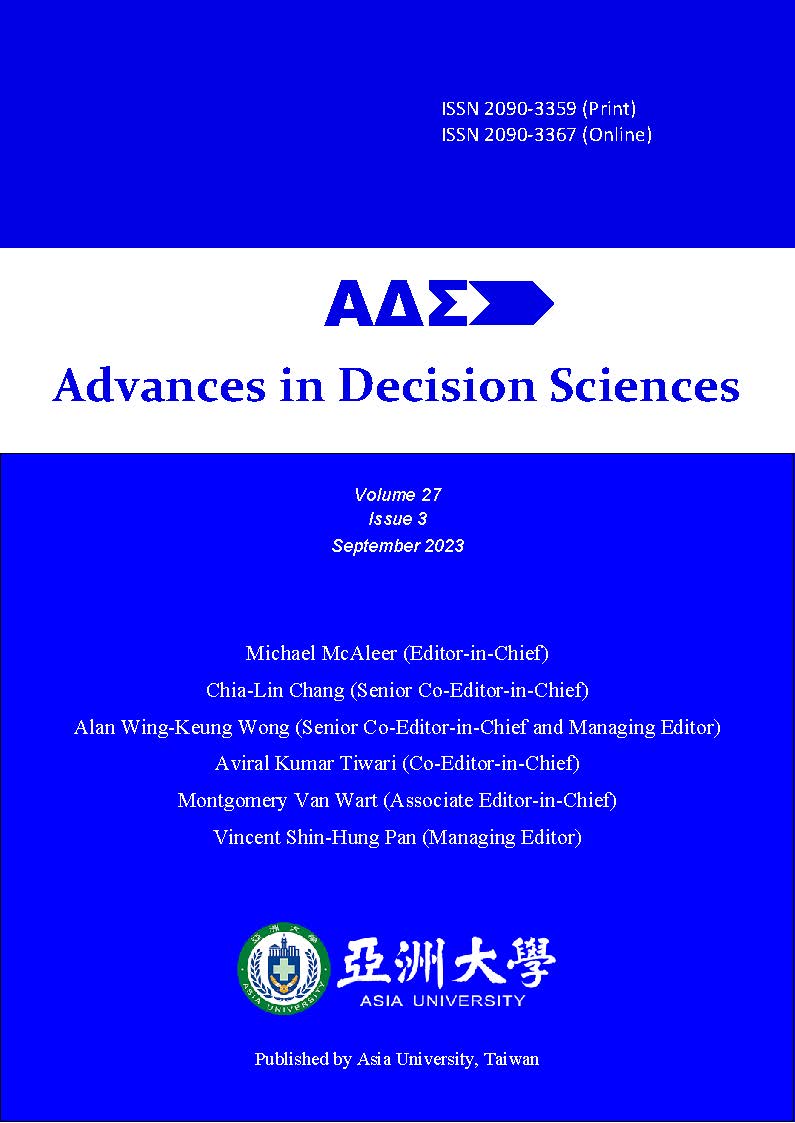Novel Standard Polynomial as New Mathematical Basis for Digital Information Encryption Process
DOI:
https://doi.org/10.47654/v27y2023i3p72-85Keywords:
Irreducible Polynomial, Lightweight Cryptosystem, Encryption, Data SecurityAbstract
Objective: The proposed approach is based on producing new irreducible polynomials that help reduce the drawbacks of traditional cryptosystems. This work demonstrates the proposed model's efficiency and applicability, which could help researchers and practitioners investigate the proposed model in different cryptosystems and other related systems. In addition, the structure of the proposed polynomial function can be implemented in different cryptosystems with lightweight processing. The primary objective of this work is to present an efficient irreducible polynomial equation that can be implemented with lightweight cryptosystems.
Methodology: The proposed work is based on computing an irreducible polynomial, which is no more than two power multiplications. The structure of the proposed irreducible polynomial is carried out by using the exhaustive search approach and experiment. The mathematical function of the new standard polynomial is applied to generate a vital sequence of the proposed cipher algorithm.
Various quantitative and statistical methods are applied to decision sciences at the individual and population levels.
Findings-. The generated sequence keys are examined and analyzed using different statistical tests. The analysis output showed a significant random behavior of the generated sequence keys of the proposed cipher algorithm compared with the original cipher algorithm.
Novelty: This work considers a new approach based on the results, the proposed model's originality, and uniqueness in the literature. This work introduced a new standard polynomial function for a lightweight cipher algorithm that was implemented to develop a new lightweight cryptosystem for the digital information encryption process. The current cryptosystems suffer from computational complexity, which exceeds the quadratic power multiplication. Thus, this work presented a new design of the digital information encryption process, which contributed to solving traditional cryptosystems' cost and performance problems.
References
Abbas, F., Ali, S., & Wong, W. K. (2022). Impact of economic freedom and its subcomponents on commercial banks’ risk-taking. Annals of Financial Economics, 17(03), 2250022.
Abdullatif, A. A., Abdullatif, F. A., & Naji, S. A. (2019). An enhanced hybrid image encryption algorithm using Rubik’s cube and dynamic DNA encoding techniques. Periodicals of Engineering and Natural Sciences, 7(4), 1607-1617.
Abdullatif, F. A., Abdullatif, A. A., & al-Saffar, A. (2018). Hiding techniques for dynamic encryption text based on corner point. Paper presented at the Journal of Physics: Conference Series.
Akif, O. Z., Ali, S., Ali, R. S., & Farhan, A. K. (2021). A new pseudorandom bits generator based on a 2D-chaotic system and diffusion property. Bulletin of Electrical Engineering and Informatics, 10(3), 1580-1588.
Ali, R. S., Akif, O. Z., Jassim, S. A., Farhan, A. K., El-Kenawy, E.-S. M., Ibrahim, A., . . . Abdelhamid, A. A. (2022). Enhancement of the CAST Block Algorithm Based on Novel S-Box for Image Encryption. Sensors, 22(21), 8527.
Ali, W., Gohar, R., Chang, B. H., & Wong, W. K. (2022). Revisiting the impacts of globalization, renewable energy consumption, and economic growth on environmental quality in South Asia. Advances in Decision Sciences, 26(3), 1-23.
Arfaoui, N., & Yousaf, I. (2022). Impact of COVID-19 on volatility spillovers across international markets: evidence from VAR asymmetric BEKK GARCH model. Annals of Financial Economics, 17(01), 2250004.
Bai, Z., Liu, H., & Wong, W. K. (2009). Enhancement of the applicability of Markowitz's portfolio optimization by utilizing random matrix theory. Mathematical Finance: An International Journal of Mathematics, Statistics and Financial Economics, 19(4), 639-667.
Bai, Z. D., Hui, Y. C., Jiang, D. D., Lv, Z. H., Wong, W. K., & Zheng, S. H. (2018). A New Test of Multivariate Nonlinear Causality, PLoS ONE 13(1): e0185155. https://doi.org/10.1371/journal.pone.0185155
Bai, Z. D., Li, H., Liu, H. X., & Wong, W. K. (2011). Test statistics for prospect and Markowitz stochastic dominances with applications. Econometrics Journal, 122, 1-26.
Bai, Z. D., Li, H., McAleer, M., & Wong, W. K. (2015). Stochastic dominance statistics for risk averters and risk seekers: An analysis of stock preferences for USA and China. Quantitative Finance, 15(5), 889-900.
Beletsky, A. (2021). An Effective Algorithm for the Synthesis of Irreducible Polynomials over a Galois Fields of Arbitrary Characteristics. WSEAS Transactions on Mathematics, 20, 508-519.
Beletsky, A. (2022). Factorization of the Degree of Semisimple Polynomials Over the Galois Fields of Arbitrary Characteristics. WSEAS Transactions on Mathematics, 21, 160-172.
Bielenova, K., Nazarenko, H., & Vishnyakova, A. (2022). A sufficient condition for a complex polynomial to have only simple zeros and an analog of Hutchinson's theorem for real polynomials. arXiv preprint arXiv:2207.08108.
Brochero-Martinez, F., Reis, L., & Silva-Jesus, L. (2019). Factorization of composed polynomials and applications. Discrete Mathematics, 342(12), 111603.
Chang, F. H., & Zhang, L. (2022). Revisiting Inflation-Growth Nexus: An Endogenous Growth Model with Financial Frictions. Annals of Financial Economics, 17(01), 1-13.
Chisadza, C., & Biyase, M. (2023). Financial Development and Income Inequality: Evidence From Advanced, Emerging and Developing Economies. Annals of Financial Economics 18(01), 2241002
Devi, S., Mahajan, R., & Bagai, D. (2022). Low complexity design of bit parallel polynomial basis systolic multiplier using irreducible polynomials. Egyptian Informatics Journal, 23(1), 105-112.
Ghazi, A. B., Mahdi, O. A., & Abdulaziz, W. B. (2021). Lightweight route adjustment strategy for mobile sink wireless sensor networks. Indonesian Journal of Electrical Engineering and Computer Science, 21(1), 313-320.
Hao, L., & Min, L. (2014). Statistical tests and chaotic synchronization based pseudorandom number generator for string bit sequences with application to image encryption. The European Physical Journal Special Topics, 223(8), 1679-1697.
Hecht, P. (2020). PQC: R-Propping of Public-Key Cryptosystems Using Polynomials over Non-commutative Algebraic Extension Rings. Cryptology ePrint Archive.
Kamal, M., & Tariq, M. (2019). Light-weight security and blockchain based provenance for advanced metering infrastructure. IEEE Access, 7, 87345-87356.
Kuang, R., Perepechaenko, M., & Barbeau, M. (2022). A new post-quantum multivariate polynomial public key encapsulation algorithm. Quantum Information Processing, 21(10), 360.
Kubba, Z. M. J., & Hoomod, H. K. (2019). A Hybrid Modified Lightweight Algorithm Combined of Two Cryptography Algorithms PRESENT and Salsa20 Using Chaotic System. Paper presented at the 2019 First International Conference of Computer and Applied Sciences (CAS).
Kubba, Z. M. J., & Hoomod, H. K. (2020). Modified PRESENT Encryption algorithm based on new 5D Chaotic system. Paper presented at the IOP Conference Series: Materials Science and Engineering.
Kumbinarasaiah, S. (2021). Novel Functional Matrix Method using Standard Basis of Polynomial Linear Space. International Journal of Applied and Computational Mathematics, 7(4), 152.
Kyriienko, O., Paine, A. E., & Elfving, V. E. (2021). Solving nonlinear differential equations with differentiable quantum circuits. Physical Review A, 103(5), 052416.
Li, H., Bai, Z., Wong, W. K., & McAleer, M. (2021). Spectrally-Corrected Estimation for High-Dimensional Markowitz Mean-Variance Optimization, Econometrics and Statistics. 24, 133-150.
Liu, H., & Niu, Y. (2022). Cryptanalysis and designing chaos-based irreversible and parallel key expansion module over Galois field. arXiv preprint arXiv:2212.05462.
Lu, T., Chen, L., Han, J., Wang, Y., & Yu, K. (2023). RIS-assisted physical layer key generation by exploiting randomness from channel coefficients of reflecting elements and OFDM subcarriers. Ad Hoc Networks, 138, 103002.
Lüthen, N., Marelli, S., & Sudret, B. (2021). Sparse polynomial chaos expansions: Literature survey and benchmark. SIAM/ASA Journal on Uncertainty Quantification, 9(2), 593-649.
Mahmood, F., Shahzad, U., Nazakat, A., Ahmed, Z., Rjoub, H., & Wong, W. K. (2022). The nexus between cash conversion cycle, working capital finance, and firm performance: Evidence From Novel Machine Learning Approaches. Annals of Financial Economics, 17(02), 2250014.
Mück, W., & Yang, Y. (2022). Krylov complexity and orthogonal polynomials. Nuclear Physics B, 984, 115948.
Nhan, D. T. T., Pho, K. H., ANH, D. T. V., & McAleer, M. (2021). Evaluating the efficiency of Vietnam banks using data envelopment analysis. Annals of Financial Economics, 16(02), 2150010.
Noman, M., Maydybura, A., Channa, K. A., Wong, W. K., & Chang, B. H. (2023). Impact of cashless bank payments on economic growth: Evidence from G7 countries. Advances in Decision Sciences, 27(1), 1-22.
Shukur, W. A., Badrulddin, A., & Nsaif, M. K. (2021). A proposed encryption technique of different texts using circular link lists. Periodicals of Engineering and Natural Sciences, 9(2), 1115-1123.
Shukur, W. A., Qurban, L. K., & Aljuboori, A. (2023). Digital Data Encryption Using a Proposed W-Method Based on AES and DES Algorithms. Baghdad Science Journal.
Suu, N. D., Tien, H. T., & Wong, W. K. (2021). The impact of capital structure and ownership on the performance of state enterprises after equitization: Evidence from Vietnam. Annals of Financial Economics, 16(02), 2150007.
Trang, L. N. T., Nhan, D. T. T., Hao, N. T. N., & Wong, W. K. (2021). Does Bank Liquidity Risk Lead To Bank’s Operational Efficiency? A Study In Vietnam. Advances in Decision Sciences, 25(4), 46-88.
Weisstein, E. W. (2002). Polynomial. https://mathworld.wolfram.com/.
Zubkov, A. M., & Serov, A. A. (2019). Testing the NIST Statistical Test Suite on artificial pseudorandom sequences. Математические вопросы криптографии, 10(2), 89-96.

Published
Issue
Section
License
Copyright (c) 2023 Advances in Decision Sciences

This work is licensed under a Creative Commons Attribution-NonCommercial 4.0 International License.







 Scientific and Business World
Scientific and Business World